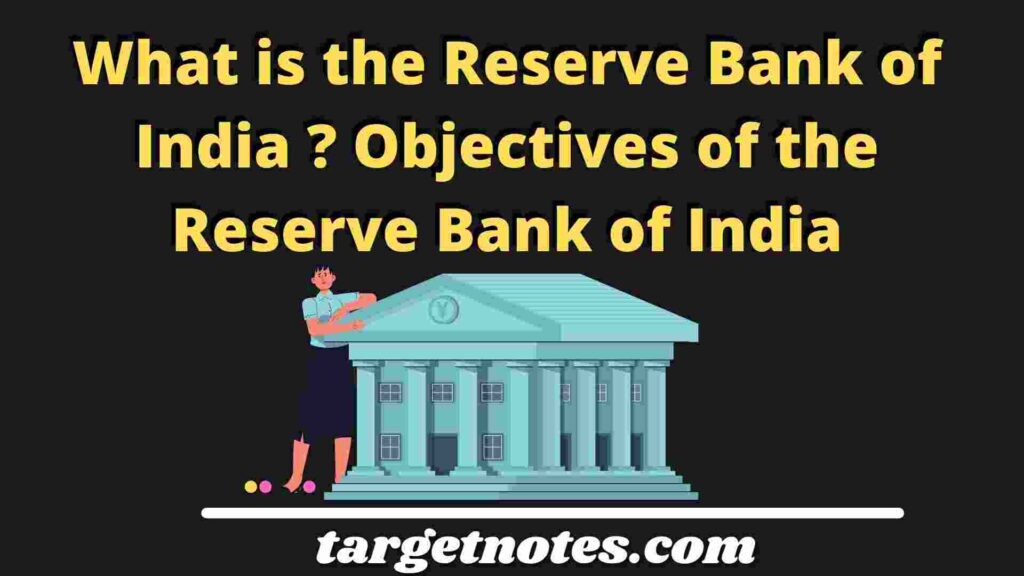
What is the Reserve Bank of India ? Discuss the objectives of the Reserve Bank of India.
Contents
Reserve Bank of India
On the basis of leading foreign central banking, the R. B. I. was constituted as a shareholder’s Bank with a share capital of Rs. 5 crores divided by 5 lakhs fully paid up shares of Rs. 100 each. The entire capital was owned by the private share capital. After sometime, it was considered desirable to incorporate in the legislation. This Bank is the bank of banks. It was established on April 1, 1935 After the 14 years of its set up, the India got freedom on 15th August 1947. The nationalist Government felt that state owned central bank is essential. Thus this Bank was nationalised on January 1, 1949.
R. B. I. was established under the Reserve Bank of India Act, 1934. Reserve Bank has right to issue note except one rupee note. Reserve Bank functions as banker of the Government of India, State Government, Commercial Banks, State Co-operative Banks etc. It also plays an important role in maintaining exchange-value of the rupee. It is a representative of the Government of India in the International Monetary Fund. It also regulates and controls commercial banking system, urban co-operative banking and non-banking financial institutions.
Objectives of the Reserve Bank of India
Following are the objectives of the R. B. I. :
1. Bringing Stability in Internal and External Prices – Internal values and external values of rupee can be made stable by the Central Bank of the country. So it is essential that credit and money should be under the control of one institution, so that inflation and deflation can be possible.
2. Co-ordination between Monetary and Credit Policy – Before the establishment of the Reserve Bank of India currency was issued by the Government of India and credit was controlled by the Imperial Bank. Due to it there was no co-ordination of currency and credit. To solve the problem, the R. B. I. was established. In the present time Reserve Bank of India constitutes the currency and credit control function.
3. Centralisation of Cash Fund – Before the Reserve Bank of India, all banks were maintaining separate funds. So, public has no confidence on banking system. In the present time all banks keep cash funds equally.
4. To Make Proper Development of the Banking System – The objective of the R. B. I. was the proper development of banking system. This function is not possible without central bank. In present time R. B. I. is like a guide for other banks.
5. Organisation of Money Market – Before the establishment of the Reserve Bank of India money was defective. To remove the defectives of money market the need of Central Bank was felt. Consequently, the R. B. I. was established.
6. Arrangement of Agricultural Credit – Before the Reserve Bank of India, agricultural credit facilities was not suitable.
7. Monetary Relations with Other Countries – It was also felt that a Central Bank should be established to make monetary contacts with other countries.
Related Link
- Describe the various types of money
- Dynamic Functions of Money
- Evils or Demerits of Money
- Importance and significance of money in Modern Economy
- Approaches regarding Definitions of Money and its Function
- Money: Meaning, Definitions and features of Money
IMPORTANT LINK
- What is the Exchange Rate System in India?
- Evolution of foreign exchange market in India
- Meaning and importance of export finance.
- Role of Export-Import Bank in Financing India’s Foreign Trade
- How Commercial banks Export Finance to Overseas Importers?
- Explain packing credit in detail?
- What is Post-shipment credit?
- What is Pre-shipment or packing credit?
- Explain Export Credit in India?
- Institutions Providing Finance and Credit Facility for Foreign Trade
- What is Risk Analysis?
- Explain Political risks in detail? and its Types
- What are the types of Risks. Explain in detail?
- Meaning and Types of commercial risks
- How can we minimize foreign trade risks?
- What are Arbitrage operations?
- Difference between Spot Market and Forward Market
- What is spot exchange?
- Agency agreement: Meaning, Features and Advantages
- Functions of Foreign Exchange markets
- structure of Foreign exchange markets
Disclaimer






